Abstract
Construction activity with a huge variety of structures, forms and conditions underlying the implementation of construction projects, require special management approach. Decisions are most often made at the planning and preparation stage of a construction project. The literature on the subject includes descriptions of decision support methods and models, including single-criteria and multi-criteria models, operations research and fuzzy models. Different models can be used in different situations. The article contains an analysis of model approaches proposed in the literature, confronted with decision-making processes in engineering practice. The study covered 34 construction projects and 15 companies operating in the construction industry. Several decision situations have been considered. The research carried out in accordance with the seven-stage research process has shown that although the various methods proposed in the cited sources can be used in the implementation of engineering projects, they require modification to suit the specificity of engineering practice. The results of the research are the decision support models proposed by the authors, adapted to the conditions in which construction projects are implemented. In the case of small and relatively simple construction projects, simplified models are usually used, where the use of the last steps of verifying the results and improving the applied model is limited. Large and more complex construction projects were often accompanied by a decision support system consisting of more stages, and in these cases, it turned out to be important to obtain feedback and to refine the decision model accordingly. Research has shown that in large projects it is important to obtain feedback. This is due to, inter alia, from the fact that the implementation of these projects involves much greater financial resources than in small and medium-sized projects. Decision-makers take much more care to verify the correctness of the model, because the effects of wrongly made decisions can be much more severe than in the case of small and medium-sized enterprises. If it is necessary to make strategic decisions related to the future of a given company, attention was paid to models in which the starting point was to clearly define the goal and collect a complete set of information about the decision-making environment. Various analytical and research methods were used, but feedback was always needed to improve the final solution. The observations obtained during the research helped the authors to develop decision support models dedicated to engineering practice that may be useful in the implementation of construction projects.
1. Introduction
There are many decision support systems used in business activities, but the very process of making a decision consists of a few stages. The literature provides information about various approach methods and models, which differ in the process of data collection and preparation, the stage of analysing the problem, or the final stage associated with the actual making of a decision [1,2]. There are models including three, eight or even as many as 11 steps in a decision-making process. Different approaches are used depending on the type of business, the decision being made, and the circumstances surrounding the decision. A decision-making process made in the well-recognised context, with a large amount of data, will look differently from one occurring in an uncertain situation. Different forms of business activities are characterised by different degrees of complexity of the executed processes, and decisions made under different conditions may affect different situations [3,4,5].
Construction activities are related to the implementation of various facilities and construction works. When we speak of the construction industry, we mean, on the one hand, the implementation of construction projects and, on the other hand, the functioning of enterprises and institutions involved in their implementation. The construction activity has some specific features. First of all, the vast majority of production is carried out outdoors and many contractors participate in the execution of works. The construction object is large compared to the products of other sectors of the economy, requires large investments and the benefits are deferred in time. Objects are implemented according to individual projects, in unique conditions with the participation of many industries. The large variety of civil structures also deserves attention. Starting from single and multi-family residential buildings, through public utility buildings for various purposes, to infrastructure structures such as roads, bridges, transmission lines and water structures. The construction process consists of several stages. At each of them, there are various participants in the involvement in the creation of the civil structures. Decisions on the works undertaken are mostly made in the planning and design phase under conditions of uncertainty with limited amounts of data. In many situations, we have to assess possible solutions and choose the variant that best meets the expectations related to the future construction (e.g., location, design concepts, material and technological solutions, preparation of tender offers, etc.) [6,7,8].
Due to the complexity of situations in which decisions in construction activity are made, the decision-making process can be supported with mathematical methods, systems and models, which allow the user to impose some order over the process and facilitate the achievement of the aim, which is to arrive at a decision [9,10].
As it is difficult to find methods and approaches dedicated to construction activities in the literature, the authors of this article attempted to examine the decision-making processes in 34 implemented projects and 15 construction companies. As a result of the research, the models used in construction activities were specified in the original, proprietary approach. Research methods were used based on the analysis of source materials, questionnaire research, interviews and in-depth interviews
The article in Section 2 presents a literature review taking into account the issues of decision-making in engineering activities, various decision models are presented, and the review is summarized in tables. Section 3 presents the methodology, details and results of the research. The next Section 4 contains a discussion of the results, and Section 5 presents a summary and conclusions.
2. Decisions—A Review of the Literature
A decision means selecting one of the available options [11]. If there are no options, there is no decision to make either. There are several methods which can lead to choosing the right solution to a problem. An example is a quantitative decision-making technique. Its underlying principle is to rely exclusively on data, which are analysed in order to generate facts. If the number of facts that justify taking a given action outweigh facts supporting other possible solutions, it becomes the decisive factor. However, this perception of a decision-making process excludes any subjective evaluation, intuition, premonition or bias, while forcing one to present the justification of their decision, which entails the demonstration of all underlying presumptions, restrictions or limitations [9].
A different situation emerges when a problem is being described with qualitative parameters. Qualitative methods apply to cases composed of hardly measurable phenomena, which are compared via descriptive analysis of different parameters. Assessment scales adopted in this approach often raise doubts, and their application needs to adhere to detailed guidelines.
It is advisable to follow previously defined principles while making decisions. The absence of such guidelines may cause chaos and eventually lead to an erroneous perception of the problem and incorrect solution. Decisions are always subject to certain limitations, due to preceding events. The main criteria, which can be evident or hidden, can be grouped as a set of aims, a system of priorities, a course of alternative measures, consequences of each alternative solution, and a system of selection criteria [12].
2.1. Decisions and Their Structure
A decision problem is defined through decision variants and assessment criteria. According to literature sources [13,14] decision problems can be divided into problems with single-layer, hierarchical and fuzzy structures. A decision system is often a single-layer system with a closed decision problem [14,15]. Figure 1 illustrates a model of the first-type structure. Di are decision areas, dij are elementary decisions in particular areas, where i = {1, 2, …, n} and j = {1, 2, …, m}. Final decisions eliminate one another within the same decision area.
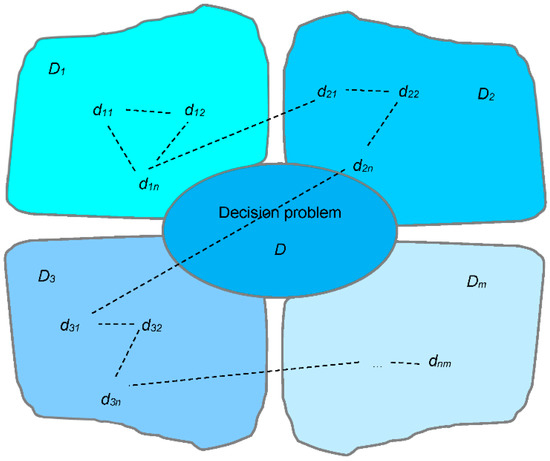
Figure 1.
Model of a flat structure decision process.
In most cases, this structure does not reflect a decision situation because decisions are taken in many areas, which means there are mutual relationships between decision problems Di. In many situations, these relationships may contribute to the quality of the final solution [16,17,18,19] Dependences between elementary decisions are depicted by a hierarchical structure of a decision problem, in which no sooner that all decision criteria of the lower-level Knm have been considered and solved can higher-level decisions be made and the final choice of decision variant Vi made (Figure 2).
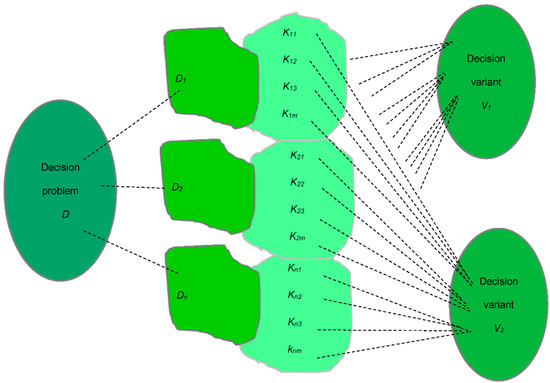
Figure 2.
Model of a decision-making process with a hierarchical structure.
The third group of decision-making situations consists of fuzzy models, where problems are shown as dependent on links and relations between different-level decision makers [20,21]. The mentioned relations include cooperation, coordination, or competition. Such relations differ in terms of information transmitted between the system’s constituents, and with respect to set boundaries of effects produced by particular decision criteria. Cooperation necessitates sharing information, while competition is associated with information non-linearity and disproportions [22,23]. The shared characteristic for both forms of relations is non-linearity and non-continuity of decision processes (Figure 3).
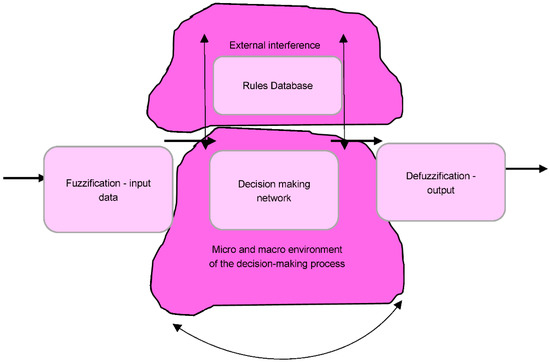
Figure 3.
Model of a fuzzy decision process.
2.2. A Decision Process
Business enterprises operate in an increasingly difficult environment, as the competition intensifies and markets are being made devoid of rules or principles. Big corporations more and more often dictate conditions in which businesses are run, both locally and globally. This tendency appears in all sectors, including the civil engineering segment [24,25]. A decision-making process is undergoing significant changes due to progressing globalisation. At all stages illustrated schematically in Figure 4, it is recommended to refer continually to the ever changing nearer and further environment. Increasingly often, the cutting edge information technologies, seen as tools of globalisation, are a source of information and datasets supporting the process of arriving at a decision [26,27,28]. Making a decision is a process that encompasses such activities as expressing the need for a decision, collecting and processing data to support the decision, measuring the outcomes and finally evaluating the execution of the chosen option and the extent to which it has satisfied the assessment criteria established at the onset of the process (Figure 4).
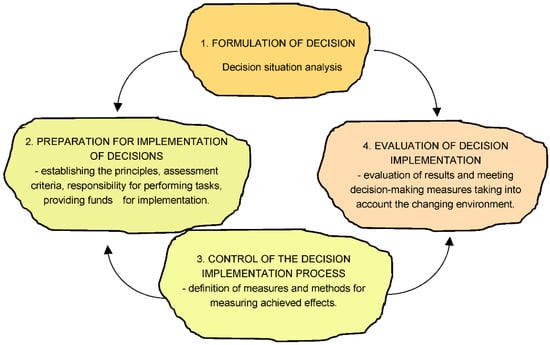
Figure 4.
The process of making and implementing a decision.
The factors that polarise conditions under which decisions are made include: decoupling of global demand from the purchasing power of local markets, narrowing of the investment horizon as a consequence of competitive struggle, and enterprises becoming more market-driven [23,29,30]. All these circumstances cause growing uncertainty, evoked by difficulty in predicting market changes and, on the other hand, by greater propensity to face investment risk in order to earn profit. In a situation where global competition is experienced, there is a tendency towards making uncontrollable decisions as well as taking steps that lead to changes in relationships between market participants. It is more and more common to observe that negative consequences of erroneous decisions are shifted over contractors and subcontractors of development projects [23,29,30].
In every process of making a decision there are decision makers, a set of feasible solutions, a set of environmental components [31], the function of the usefulness of a solution [32] and uncertainty with respect to conditions in which actions will be pursued [4]. A decision maker is a person who is responsible for the consequences of the solution eventually accepted. A set of feasible solutions should not violate certain limits and ought to be doable. This set must not be empty and needs to contain at least two elements. The set of environmental components describes the conditions in which the decision-making process occurs, and which either directly or indirectly affect the decisions that are made [22].
The objective function is a way to assign numerical values to the values of a solution being searched for. If usefulness can be described numerically, attaining high accuracy, this is a suitable criterion for making a decision. By assigning certain contractual values to decisions, we reduce the decision-making process to a situation where the option with the highest usefulness is chosen. If a decision maker is unable to evaluate the probability of the occurrence of particular events, the external environment is said to be uncertain.
2.3. Models of a Decision-Making Process
The approaches used in a decision-making process depend on the type of a problem. The most popular methods are: linear programming, dynamic programming, integer programming, the Bayes’ decision theorem, game theory, and probability theory. These methods belong to the quantitative research domain. As events are described through sets of norms, principles and algorithms, the above methods are classified as prescriptive models. However, prescriptive models may not always offer satisfying solutions. Due to some subjective circumstances, such as qualifications and skills of decision makers, as well as objective ones, arising from external and internal conditions, prescriptive models do not always work well. In certain situations, descriptive models (describing and explaining the situation) are more useful. An analysis is then conducted starting from single cases up to generalised conclusions.
Depending on an analysed situation, different decision support models are applied. The subsequent part of this article will present issues connected with the application of prescriptive models. The models are described in literature (Table 1).

Table 1.
Models of a decision-making process—literature review.
The authors who present decision models suggest different procedures, referred in the literature as decision models. Table 2 presents models that are used in the broadly understood engineering activity and in scientific research related to this field.

Table 2.
Models of decision-making processes.
The Table 2 shows two major groups of models—one where the process begins by identifying the problem, and the other where the procedure is based on building a decision model. The first group includes methods which take advantage of single-criterion and multiple-criteria approaches whose aim is to make an assessment of several variants or alternative solutions. In these models, the assessment leads to the identification of the best solution, its implementation and possibly the evaluation of the effects attained.
The second group consists of methods based on building a mathematical model, which through the mathematical language presents the decision situations described previously. These methods require the user to prepare primary information, to identify the goal and the measure that will be applied to determine to what degree this aim is reached. The final stage provides feedback that enables the user to correct the model or decision if necessary.
The models presented in the table differ from one another in both the approach to the problem being solved and the subsequent procedures, but in each case the completed procedure leads to the solution of a problem. Different approaches may apply to different decision situations, in different fields of business activity.
An analysis of the literature related to decision making and research carried out in construction companies and during erection of civil structures revealed the lack of decision models adapted to the specificity of construction activities. The article undertakes research on source materials in order to find an answer to the question of how the decision-making processes in construction look similar to in practice, what stages they consist of and whether they fit into the models described in the literature, and as a result of the research, models of decision-making processes taking into account the specificity of this industry were proposed.
The purpose of this article is to develop a decision support model dedicated to the construction activity.
3. Research Methodology, Course and Results
3.1. Research Methods
Developers, investors and construction companies were questioned about decision-making issues in order to identify decision problems which appear in construction activity. From among all companies based in north-eastern Poland, those that have been involved in the construction of facilities representing very diverse types of engineering structures over the last five years have been selected. The preliminary selection was accomplished on the basis of information obtained in offices of district and provincial authorities, including issued building permits.
The first part of the interview concerned determining who and when made decisions. Groups of decision-makers related to the projects were established, and then at which stage these decisions were made (preparation and planning stage, design stage, execution and completion stage). The frequency of making decisions in subsequent stages and in specific decision groups was also examined. The main problem that has been studied is the way of making decisions including preparation stages (e.g., problem identification, context analysis, collecting output data), creating a decision model, defining criteria or sending feedback to correct the assumptions underlying the decision.
The subsequent stage in the research consisted of contacting the selected respondents and having preliminary interviews in order to find out who and how made decisions regarding the ongoing development projects. The character, type and frequency of decisions made were also investigated. These preliminary interviews allowed us to distinguish a group of 34 civil structures under construction. This research stage employed the following methods: an analysis of information sources, probes, surveys, and in-depth interviews. The study covered the years 2015–2019.
The analysed objects were divided into small, medium and large construction projects. The classification of construction objects to these groups takes into account the nature of the object and looks different for road, bridge and environmental protection structures. On the one hand, the size and complexity of the facility is evidenced by the number of subcontractors and, as a rule, there are about 5–6 of them for small facilities, about 10–12 medium ones and more than 14. However, due to the nature of the facilities and the degree of compilation, there are deviations. The value and volume of works was assessed based on the opinions of contractors and investors. In order to obtain their opinion, a list of parameters determining the classification of the construction to a specific group was prepared. These are, among others the size and complexity of the structure and related construction works, the size of the construction site, including the number and size of auxiliary factories, the distances between important points on the construction site, the complexity of the processes carried out during the construction of facilities. Most of the components of the analysis are immeasurable phenomena, therefore the linguistic and descriptive assessment methods were used, which, based on the description of the phenomenon, allow them to be assessed on the adopted 5-point scale. The scores were summed up and assigned to one of the three size groups for the final grade.
The research, the purpose of which was to develop decision models tailored to the specificity of construction activities, was carried out in 7 stages, including previously planned activities. The diagram of the research process presenting the research methodology is presented in Figure 5.
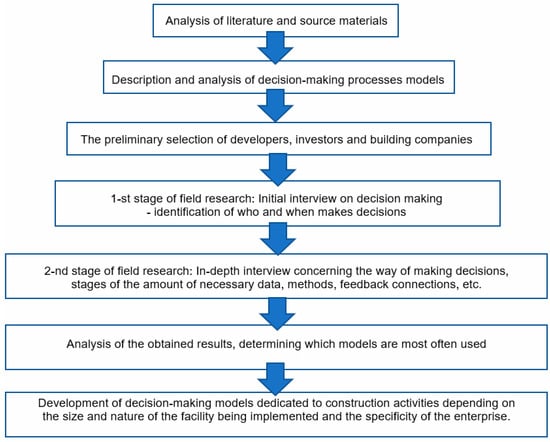
Figure 5.
Scheme of research process.
3.2. The Course of the Research
The research has shed light on what problems are most often solved in a systematic manner. First and foremost, these are analyses of variant locations of different development projects. In such cases, decision makers most often use methods based on a multiple-criteria analysis, although the number of steps included may differ slightly, largely depending on the size and complexity of a construction project. Another example of a situation where alternative solutions need to be analysed and selected is a tender, in which the bids are assessed according to previously determined parameters. In a few cases, an analysis of several variants was applied to building material and construction solutions.
Detailed data collected during the study and pertaining to decisions made with respect to possible variants of erection of civil structures are presented in Table 3.

Table 3.
Specification of the information gathered about decision models applied to select variants (Erection of civil structures).
Among the analysed civil structures and decision situations connected with their execution, over 40% were road construction projects. Such a large proportion of new roads is the result of the rapidly growing road construction sector stimulated by the EU funds. The second most numerous type of civil engineering projects was the construction of environmental protection facilities. Same as roads, they were mostly built with the contribution of EU funds. Bridges as civil engineering constructions associated with road construction made up 15% of the analysed projects. Each of the remaining types of civil structures corresponded to less than 10% of the total. As many as 4 out of 6 large civil structures represented road structures. Participation in the study each type of objects is presented in the diagram in Figure 6, and the percentage share of various venture in the group of large objects chart in Figure 7.
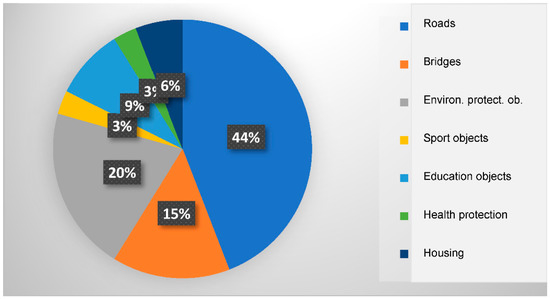
Figure 6.
Participation in the study each types of civil structures.
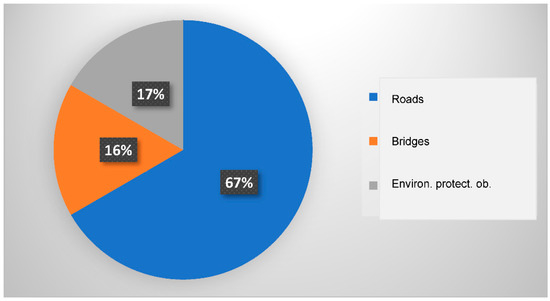
Figure 7.
Percentage share of various venture in the group of large civil structures.
The research comprised 6 construction projects classified as large or as highly complex ones. There was the same number of medium-sized and small civil structures (14 civil structures). The percentage of these projects in the total analysed number is illustrated in Figure 8.
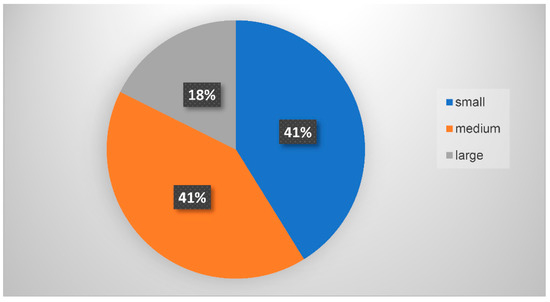
Figure 8.
Percentage share of small, medium and large civil structures in research.
The focus in our study was on decision-making processes which occurred during the execution of the analysed construction projects. A review of the documents made available by the companies supplied a wealth of information about these processes. The models used by the decision makers engaged in the analysed cases most often belonged to model II, i.e., more or less advanced methods of multi-criteria analysis. As many as 25 out of 35 analysed cases took advantage of this model. Some other details regarding the applied models are shown schematically in Figure 8.
From Figure 9, it is clear that Model 5 was not used in any of the analysed cases of construction projects implementation. It is a model based on more advanced mathematical methods and there is no tradition of using these models by the engineering community. Model 5 has found wide application in enterprises when making decisions related to business strategies. This is due to, inter alia, of the fact that construction companies usually employ people with professional training (marketing and management, economics) that allows them to apply operational research in management-related departments. There is a rather shortage of such people when carrying out the works. Models 6 and 7 were not used in both the implementation of projects and business decisions. These methods require much more advanced research tools and are rather used in scientific research on construction activities and not in engineering practice.
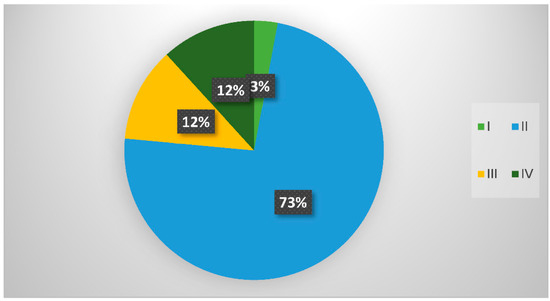
Figure 9.
The percentage of different decision-making models used in the studied projects.
Another case associated with making a decision which drew our attention was a change in the profile of operations performed by a given company and the scope of its activities. Such decisions belong to strategic ones, and they are made on the basis of large databases and raw information. A number of building companies operating in the north-eastern part of Poland were analysed in our study. It was found that the construction sector was doing quite well, especially in comparison with other sectors of the economy and despite some symptoms heralding a crisis. Most of the analysed companies did not feel the urge to change the profile of their business activity. Only 15 declared they needed to make amends or widen the scope of operations. Decisions to make such changes were preceded by analyses of the market, area of operations or position of competitors. When making such decisions, it was common to run simulation studies based on analyses of preferences of clients, investors and relative branches of economy. In some cases, an analysis of variant solutions was performed according to the method of multi-criteria analysis. Detailed findings in this regard are presented in Table 4.

Table 4.
Specification of the information on strategic decisions (concerning a change in the profile and scope of business).
Decision problems in the companies submitted to our study also pertained to such situations as a change in the profile of business, a change or broadening of the scope and area of business activities. The number of such situations was quite evenly distributed among the types of companies. Details can be seen in Figure 10.
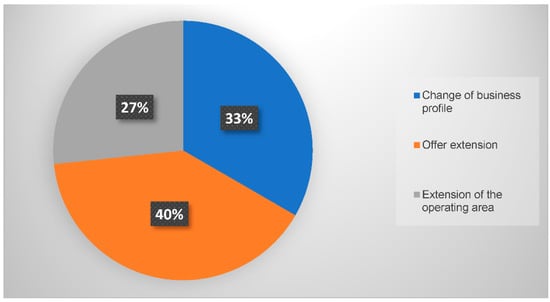
Figure 10.
Percentage share of examined decisions.
Within this research group, it is possible to notice a much higher frequency of models V—operations studies, and III—Sutherland’s model. Both models comprise extended final stages where some feedback is expected in order to improve the developed model. When dealing with strategic decisions, the interviewed decision makers attached much importance to this component of an analysis.
Detailed information such as the percentage of each model in the total research sample is presented in Figure 11.
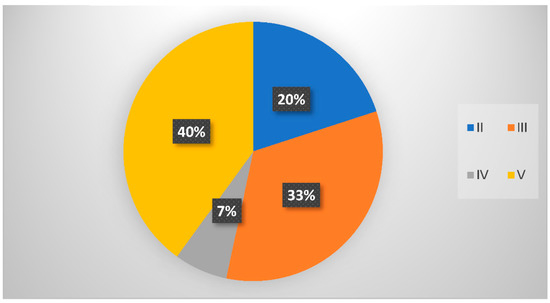
Figure 11.
Percentage share of decision models in the research sample.
3.3. Mathematical Methods Used to Support the Analysed Decision-Making Processes
This study also comprised an analysis of the methods for evaluation of variant decisions, applied in all the models. Building investments and civil structures have own specific characteristics, and therefore not all the available methods can be applied in practice. The most important feature expected from decision-support methods employed in the construction business is their capacity for including a large number of criteria of various character. At the stage when variant solutions are compared, it is unnecessary to use a binary assessment; what is actually needed is to determine the degree to which each variant solution satisfies a given parameter. Another essential requirement is to be able to develop descriptive assessment scales that will be readable and easy to use. To use variant evaluation methods in practice, it is also important to have a relatively simple mathematical apparatus and to present the results clearly. Thus, in the construction activity, a certain group of methods tends to prevail. An analysis of an investment for which an evaluation of alternative solutions has been made shows that these are mostly methods where scores are assigned to assessed variants. The formula for calculating an aggregated assessment of variant ‘i’ is as follows (1):
where:
- cij—the assessment of a variant expressed in points scored for criterion cj by variant vi,
- Fi—total aggregated assessment of variant vi, (i = 1, 2, …, m).
Another equally popular approach is to make an evaluation of solutions that takes into account the varied importance of criteria. This method is sometimes called the weight-score method or the weighted sum method. Here, every criterion is assigned a weight, which facilitates a more effective evaluation of the variants, which takes into account the specific character of the project submitted to evaluation. The sum of weights should always equal 1.0. The problem can be written as (2):
where:
- cij—the assessment expressed in points scored for criterion cj by variant vi,
- wj—weights.
The following formulas can be used when aggregating mid-term evaluations in scalar methods:
- arithmetic mean (3):
- arithmetic weighted mean (4):
- sum of arithmetic weighted mean (5):
Yet another popular method, admittedly more mathematically advanced, is the Analytic Hierarchy Process (AHP) approach, created in the 1980s by T. Saaty. The method owes its popularity to the fact that it approaches the problem of making an assessment by ordering criteria and arranging them in groups of main criteria, after which hierarchical evaluation is performed, which leads to the determination of vectors of the main criteria and subordinate criteria. The mathematical formula relies of a pairwise comparison matrix and proceeds according to the following template:
- Calculation of the value of a normalized matrix (6):
- Determination of the value of the vector of sub-priorities (7):where (8):
In order to verify whether the above-mentioned procedures has been correct, we determine:
- The matrix’s own maximum value (9):
- Value of the consistency index (10):
- Consistency ratio (11):where:
- the C.R. should reach a value < 10%
- R.I.—random index, the value of which depends on the “n” number of compared components [19,22].
In addition to selecting and evaluating variant solutions, linear programming methods leading to the optimization of operations are employed in the management of enterprises in the construction activity. A mathematical model of a linear programming problem (12):
with limitation (13):
- (i = 1, …, m)
- (j = 1, …, n)
- xj ≥ 0
An example of the use of one of the methods is presented below. The example mentioned earlier involves the process of making a decision about the location of a production facility in a situation where four variants were available. Six groups of main criteria were used to evaluate each of them, and in each group from three to six factors. In total, the degree of fulfilment of 21 factors was assessed. The evaluation was carried out with the most frequently used weight-score method. Details of the analysis are presented in Table 5 and Table 6.

Table 5.
List of weights values obtained for the main and sub-criteria.

Table 6.
List of the results of the variant assessment using the weight-score method.
The results of the calculations after summing up indicate the best-ranked solution.
4. Discussion of the Obtained Results
The research results concerning decisions about which variant solution to choose (Table 3) show that such decision-making situations are evidently dominated by the multi-criteria decision support methods (model II), and this model is particularly preferred in cases of construction projects classified as small and medium-sized ones. This is mostly connected with the character of decisions and specific situations generating numerous assessment criteria. In 25 of the analysed cases, one of the multi-criteria analytical methods was employed. Meanwhile, it could be noticed that the structure of models applied was diverse—the observations show that the eight-step decision support scheme recommended in the literature was employed in 11 cases, while in 8 cases the process was shorter by one stage, hence only seven steps were followed, in contrast to 6 other cases, where the procedure was extended by one stage. The application of the eight-step procedure appeared in construction projects classified as small and medium-sized, while longer procedures appeared in medium-sized projects. Further investigations revealed that the shortening of the procedure in small construction projects affected the final stage. Decision makers skipped the stage of evaluating the effectiveness of the decision they made. They concluded that it was unnecessary in the case of less complicated construction projects. The lengthening of the process in medium-sized construction projects differed in character. In two cases (road construction), the procedure required one more final stage to be added, such as transmitting the feedback in order to correct the decision model adopted at the beginning. In other cases, the stage of input information preparation, intended to help recognise difficulties in executing a given construction project, was expanded to enable identification of problems.
Model III—the Sutherland’s model, was applied on four occasions in construction projects classified as large ones. In all the cases, it was reduced to ten steps, and the description of the performed analyses explained that the collection of information and data was combined with empirical research into a single stage (stages 2 and 3).
Model IV—the Holt’s model, very close to a multi-criteria model, appeared on 4 occasions. In a form lengthened by adding an additional stage it was used in large construction projects, whereas in the form recommended in the literature, i.e., composed of 8 stages, it was employed in medium-sized civil structures. The lengthening of the process consisted of a stage of obtaining feedback in order to correct the process in the case of large and complicated construction projects.
Model I proved to be far less useful in a decision-making process in construction projects, as it only appeared in one case. A decision supported by a single-criterion model does not allow the user to analyse complicated construction processes.
Table 4 contains the information about the decision-making processes concerning development strategies of construction companies. It shows that other decision support models were applied in this case. Six cases of using model V, 5 cases of using model III, 3 cases of using model II and 1 case of using model IV were observed.
Model V was mainly employed when making a decision to broaden the range of services offered. The application of this model entailed market analysis and studies of clients’ preferences. In one case, this model was used to plan a change in the company’s business profile, and once it served to make a decision to expand the operation area. The adopted model was verified in all but one cases. This model is based on operations studies, it takes into consideration the use of linear and non-linear programming, and it offers many possibilities with respect to modelling decision problems.
Model III was as just popular as Model V (5 cases). Model III enables the user to carefully prepare and conduct the entire decision-making process. By going through 11 stages, one is able to prepare input data more accurately and to verify the outcome. This model was applied in various situations, but its implementation was associated with an assessment of different variant solutions.
Model II, which was used in three of the analysed cases, is similar in principle but less expanded. It was used only when making a decision to change the company’s business profile. No verification of the model was noticed in any of the three cases. Model IV, close in its philosophy to model II, appeared only once, when analysing a possibility of broadening the offer, and it was not verified either. Noteworthy is the fact that the cybernetic model was not used at all.
The research reported in this article showed that the most popular decision support methods employed in the construction industry when making an assessment of variant solutions are multi-criteria analytical methods and models which make use of such analyses. The study comprised problems of making decisions while performing small, medium-sized and large construction projects, characterised by different degrees of complexity. It was found that decision support models were somehow modified by users and the modifications depended on the nature of a construction project. The interviews and analyses of all studied cases enabled us to elaborate and suggest decision support models dedicated to the construction sector, including such aspects as the size of a construction project and its complexity.
Suggested decision support models useful when selecting variant solutions in the construction sector:
- A model useful for small and medium-sized, less complicated construction projects:
- Study the decision situation
- Define the problem
- Determine criteria applied to assess solutions to the problem
- Develop variant solutions to the problem
- Select a method to assess the solutions
- Assess and select the best solution
- Implement the solution
- A model for medium-sized and large, complicated construction projects:
- Analyse the environment and collect information
- Define the problem causing difficulties
- Determine criteria for the assessment of solutions to the problem
- Develop variant solutions
- Select a method for making an assessment of the possible solutions
- Assess all variant solutions and select one
- Make a decision
- Implement the decision
- Obtain feedback
- Correct the input data, underlying assumptions
Making strategic decisions is most often supported by models III and V. When a decision to be made concerns the future of a company, the most important stage was to collect a complete set of information about the environment (model III), as well as being able to describe the decision situation using a mathematical language (model V) and obtaining feedback which allows the user to verify the model, and in consequence to improve the decision-making process.
Our suggestion of a decision support model for strategic decisions, based on this research and on experiences gained by building companies looks as follows:
- Identifying the need to make a decision (define the aim).
- Collecting information about the environment.
- Building a model (in some cases, describing the situation with a mathematical language).
- Generating solutions to the decision problem.
- Making an evaluation of the variant solutions.
- Verifying the model.
- Obtaining feedback to correct the model.
- Receiving the corrected solution.
- Implementation.
The models designed on the basis of this study take into account the specific nature of civil engineering practice. The analysed research material led to the identification of three basic decision situations: (I) connected with the execution of large and medium-sized construction projects that are highly complex, (II) smaller and less complicated construction projects, and (III) situations when strategic decisions are made in a construction company. The approach recommended in this article is universal and can be useful in practice.
Apart from the tested models applicable in construction, attention should also be paid to the “desirability function approach” used in industrial engineering. This method has been used, among others. for testing the optimal geometry of tall buildings. Its quantitative, relatively simple nature could be used in decision-making processes related to the implementation of complex construction projects [52,53,54,55]. This method deserves attention and will be the subject of further research by the authors.
The analysis of the popularity of mathematical methods showed that the commonly used methods are the score and the weighted score ones, which were used in 82% of the analysed investments, in 85% of road and bridge developments, and in 78% of developments connected with environmental protection, which were the most numerous type of development in the time period analysed. The prevalent methods were weighted score ones, which allow the user to stress the importance of some of the criteria. The AHP approach was used as a decision-support tool in 11% of the total number of investments. The remaining 7% had other assessment methods employed, e.g., a linguistic-descriptive method (schools and other education facilities as well as health care facilities), and in one case, which was a sports facility, the developer used a binary relationship model. Linear and non-linear optimization methods were employed to support business decisions in the management of companies. They were used in over 60% of the analysed cases.
5. Summary and Conclusions
Every business activity is invariably connected with making decisions. There are several decision support systems available in management practice. To improve the decision-making process, various model approaches have been developed that use different mathematical tools.
To diagnose the problem of modelling the decision-making process in construction activities, the author of the article, provided that the research covered 34 construction projects and 15 companies operating in the construction industry. The sections include that the methods and approaches described in the literature are also used in engineering practice, although they are subject to certain modifications due to the specificity of this sector, as well as there are no universal methods and procedures modelling decision making. manufacturing process in construction companies.
In the case of small and relatively simple construction projects, simplified models are usually used, where the use of the last steps of verifying the results and improving the applied model is limited. Decision makers pay special attention to the reliable preparation of input data for analysis in the decision-making process. Large and more complex construction projects were often accompanied by a decision support system consisting of more stages, and in these cases, it turned out to be important to obtain feedback and to refine the decision model accordingly.
Research has shown that in large projects it is important to obtain feedback. This is due to, inter alia, from the fact that the implementation of these projects involves much greater financial resources than in small and medium-sized projects. Decision-makers take much more care to verify the correctness of the model, because the effects of wrongly made decisions can be much more severe than in the case of small and medium-sized enterprises.
If it is necessary to make strategic decisions related to the future of a given company, attention was paid to models in which the starting point was to clearly define the goal and collect a complete set of information about the decision-making environment. Various analytical and research methods were used, but feedback was always needed to improve the final solution.
The observations obtained during the research helped the authors to develop decision support models dedicated to engineering practice that may be useful in the implementation of construction projects.
The results of the conducted research indicate that the problem of decision making in construction is wide, decisions are diverse and made in various situations. This topic is not discussed in the literature and it is difficult to find decision models dedicated to construction activities. The literature review shows a variety of approaches used in various areas of the economy. They can be adapted to various purposes, but do not take into account their specificity. For example, decisions in construction processes are always subject to certain limitations due to preceding events. The main criteria, which may be obvious or hidden, can be grouped into a set of goals, a priority system, a course of alternative actions, the consequences of each alternative solution, and a system of selection criteria.
The research does not exhaust the research issues and will be continued to take into account, inter alia, the conditions of uncertainty and risk accompanying the decisions made. Attention should also be paid to the “desirability function approach” used in industrial engineering. This meth-od has been used, among others. for testing the optimal geometry of tall buildings. Its quantitative, relatively simple nature could be used in decision-making processes related to the implementation of complex construction projects.
Author Contributions
E.S.: conceptualization, methodology, survey research, data analysis, resources study, writing-original draft preparation, writing—review and editing, visualization; J.H.: survey research, data analysis, resources study. All authors have read and agreed to the published version of the manuscript.
Funding
This research received no external funding.
Institutional Review Board Statement
Not applicable.
Informed Consent Statement
Not applicable.
Data Availability Statement
Not applicable.
Acknowledgments
We would like to acknowledge every people from construction enterprises for taking part in the survey research.
Conflicts of Interest
The authors declare no conflict of interest.
References
- Alexandre, L.A. Gender recognition: A multiscale decision fusion approach. Pattern Recognit. Lett. 2010, 31, 1422–1427. [Google Scholar] [CrossRef]
- Hazır, O. A review of analytical models, approaches and decision support tools in project monitoring and control. Int. J. Proj. Manag. 2015, 33, 808–815. [Google Scholar] [CrossRef]
- Klincewicz, K. (Ed.) Management, Organization and Organization. Review of Theoretical Perspectives; Scientific Publishing House of the Faculty of Management at the University of Warsaw: Warsaw, Poland, 2016. [Google Scholar]
- Matyas, K.; Nemeth, T.; Kovacs, K.; Glawar, R. A procedural approach for realizing prescriptive maintenance planning in manufacturing industries. CIRP Ann. 2017, 66, 461–464. [Google Scholar] [CrossRef]
- Szafranko, E. Decision problems in management of construction projects. In Proceedings of the 3rd International Conference on Innovative Materials, Structures and Technologies, Riga, Latvia, 27–29 September 2017; Volume 251, p. 012048. [Google Scholar] [CrossRef]
- Dachowski, R.; Kostrzewa, P. The use of waste materials in the construction industry. Procedia Eng. 2016, 161, 754–758. [Google Scholar] [CrossRef]
- Radziszewska-Zielina, E.; Śladowski, G. Supporting the Selection of a Variant of the Adaptation of a Historical Building with the Use of Fuzzy Modelling and Structural Analysis. J. Cult. Herit. 2017, 26, 53–63. [Google Scholar] [CrossRef]
- Cook, C.; Brismée, J.M.; Pietrobon, R.; Sizer, P., Jr.; Hegedus, E.; Riddle, D.L. Development of a quality checklist using Delphi methods for prescriptive clinical prediction rules: The QUADCPR. J. Manip. Physiol. Ther. 2010, 33, 29–41. [Google Scholar] [CrossRef]
- Citherlet, S.; Defaux, T. Energy and environmental comparison of three variants of a family house during its whole life span. Build. Environ. 2007, 42, 591–598. [Google Scholar] [CrossRef]
- Verbeeck, G.; Hens, H. Life cycle inventory of buildings: A contribution analysis. Build. Environ. 2010, 45, 964–967. [Google Scholar] [CrossRef]
- Szafranko, E. The choice of variant technologies and materials supported by multicriteria methods and an assessment of variants with graphic profiles of criteria. Mater. Today Proc. 2018, 5, 2002–2009. [Google Scholar] [CrossRef]
- Zavadskas, E.K.; Turskis, Z. Multiple criteria decision making (MCDM) methods in economics: An overview. Technol. Econ. Dev. Econ. 2011, 17, 397–427. [Google Scholar] [CrossRef]
- Beheshti, R. Design decisions and uncertainty. Design Studies 1993, 14, 85–95. [Google Scholar] [CrossRef]
- Sobotka, A.; Sagan, J. Cost-saving Environmental Activities on Construction Site–Cost Efficiency of Waste Management: Case Study. Procedia Eng. 2016, 161, 388–393. [Google Scholar] [CrossRef]
- Liu, A.M.; Leung, M.Y. Developing a soft value management model. Int. J. Proj. Manag. 2002, 20, 341–349. [Google Scholar] [CrossRef]
- Kaklauskas, A.; Zavadskas, E.K.; Trinkunas, V. A multiple criteria decision support on-line system for construction. Eng. Appl. Artif. Intell. 2007, 20, 163–175. [Google Scholar] [CrossRef]
- Marques, G.; Gourc, D.; Lauras, M. Multi-criteria performance analysis for decision making in project management. Int. J. Proj. Manag. 2011, 29, 1057–1069. [Google Scholar] [CrossRef]
- Radziszewska-Zielina, E.; Szewczyk, B. Supporting partnering relation management in the implementation of construction projects using AHP and fuzzy AHP methods. Procedia Eng. 2016, 161, 1096–1100. [Google Scholar] [CrossRef]
- Saaty, T.L. Decision making with the analytic hierarchy process. Int. J. Serv. Sci. 2008, 1, 83–98. [Google Scholar] [CrossRef]
- Juan, Y.K.; Gao, P.; Wang, J. A hybrid decision support system for sustainable office building renovation and energy performance improvement. Energy Build. 2010, 42, 290–297. [Google Scholar] [CrossRef]
- Schabowicz, K.; Hoła, B. Application of artificial neural networks in predicting earthmoving machinery effectiveness ratios. Arch. Civ. Mech. Eng. 2008, 8, 73–84. [Google Scholar] [CrossRef]
- Szafranko, E. Possibilities of application of multi-criteria analysis methods to evaluate material and technological solutions in the design of building structures. Mater. Today Proc. 2019, 19, 1945–1948. [Google Scholar] [CrossRef]
- Trivedi, A.; Singh, A. A hybrid multi-objective decision model for emergency shelter location-relocation projects using fuzzy analytic hierarchy process and goal programming approach. Int. J. Proj. Manag. 2017, 35, 827–840. [Google Scholar] [CrossRef]
- Scherer, R.J.; Schapke, S.E. A distributed multi-model-based management information system for simulation and decision-making on construction projects. Adv. Eng. Inform. 2011, 25, 582–599. [Google Scholar] [CrossRef]
- Svenson, O. Differentiation and consolidation theory of human decision making: A frame of reference for the study of pre-and post-decision processes. Acta Psychol. 1992, 80, 143–168. [Google Scholar] [CrossRef]
- Szafranko, E.; Srokosz, P. Applicability of the theory of similarity in an evaluation of building development variants. Autom. Constr. 2019, 104, 322–330. [Google Scholar] [CrossRef]
- Szymanowski, W. Conditions of using information technologies to model decision-making processes in an enterprise. Ann. Coll. Econ. Econ./Wars. Sch. Econ. 2017, 45, 145–157. [Google Scholar]
- Cheng, M.Y.; Roy, A.F. Evolutionary fuzzy decision model for construction management using support vector machine. Expert Syst. Appl. 2010, 37, 6061–6069. [Google Scholar] [CrossRef]
- Guerry, A.D.; Ruckelshaus, M.H.; Arkema, K.K.; Bernhardt, J.R.; Guannel, G.; Kim, C.K.; Spencer, J. Modeling benefits from nature: Using ecosystem services to inform coastal and marine spatial planning. Int. J. Biodivers. Sci. Ecosyst. Serv. Manag. 2012, 8, 107–121. [Google Scholar] [CrossRef]
- Tamošaitiene, J.; Bartkiene, L.; Vilutiene, T. The new development trend of operational research in civil engineering and sustainable development as a result of collaboration between german-Lithuanian-Polish scientific triangle. J. Bus. Econ. Manag. 2010, 11, 316–340. [Google Scholar] [CrossRef]
- Harasymiuk, J. Analysis of selected environmental procedures for construction investments. Ecol. Eng. 2017, 18, 79–88. [Google Scholar] [CrossRef][Green Version]
- Bucoń, R.; Sobotka, A. Decision-making model for choosing residential building repair variants. J. Civ. Eng. Manag. 2015, 21, 893–901. [Google Scholar] [CrossRef]
- Bolesta-Kukułka, K. Managerial Decisions in Management Theory and Practice; Scientific Publishers of the Faculty of Management at the University of Warsaw: Warsaw, Poland, 2000. [Google Scholar]
- Berredo, R.C.; Cruz, E.C.; Ekel, P.Y.; Junges, M.F.D.; Contijo, M.M.; Pereira, J.G., Jr.; Popov, V.A. Monocriteria and multicriteria optimization of network configuration in distribution systems. In Proceedings of the WSEAS International Conference on Power Engineering Systems, Tenerife, Canary Islands, Spain, 4–6 July 2005; pp. 117–122. [Google Scholar]
- Kasharin, D.V. Intelligent decision support systems in the design of mobile micro hydropower plants and their engineering protection. In Proceedings of the First International Scientific Conference “Intelligent Information Technologies for Industry”(IITI’16), Sochi, Russia, 16–21 May 2016; pp. 239–248. [Google Scholar] [CrossRef]
- Opricovic, S.; Tzeng, G.H. Defuzzification within a multicriteria decision model. International Journal of Uncertainty. Fuzziness Knowl.-Based Syst. 2003, 11, 635–652. [Google Scholar] [CrossRef]
- Barker, T.J.; Zabinsky, Z.B. A multicriteria decision making model for reverse logistics using analytical hierarchy process. Omega 2011, 39, 558–573. [Google Scholar] [CrossRef]
- Cheng, M.Y.; Hsiang, C.C.; Tsai, H.C.; Do, H.L. Bidding decision making for construction company using a multi-criteria prospect model. J. Civ. Eng. Manag. 2011, 17, 424–436. [Google Scholar] [CrossRef]
- Sutherland, J.W. Administrative Decision-Making: Extending the Bounds of Rationality; Van Nostrand Reinhold: New York, NY, USA, 1977. [Google Scholar]
- Chatterjee, P.; Banerjee, A.; Mondal, S.; Boral, S.; Chakraborty, S. Development of a hybrid meta-model for material selection using design of experiments and EDAS method. Eng. Trans. 2018, 66, 187–207. [Google Scholar]
- Hutchins, M.J.; Sutherland, J.W. An exploration of measures of social sustainability and their application to supply chain decisions. J. Clean. Prod. 2008, 16, 1688–1698. [Google Scholar] [CrossRef]
- Clithero, J.A. Improving out-of-sample predictions using response times and a model of the decision process. J. Econ. Behav. Organ. 2018, 148, 344–375. [Google Scholar] [CrossRef]
- Karimi, S.; Papamichail, K.N.; Holland, C.P. The effect of prior knowledge and decision-making style on the online purchase decision-making process: A typology of consumer shopping behavior. Decis. Support Syst. 2015, 77, 137–147. [Google Scholar] [CrossRef]
- Zhang, X.; Wu, Y.; Shen, L.; Skitmore, M. A prototype system dynamic model for assessing the sustainability of construction projects. Int. J. Proj. Manag. 2014, 32, 66–76. [Google Scholar] [CrossRef]
- Turskis, Z.; Gajzler, M.; Dziadosz, A. Reliability, risk management, and contingency of construction processes and projects. J. Civ. Eng. Manag. 2012, 18, 290–298. [Google Scholar] [CrossRef]
- Vukomanovic, M.; Radujkovic, M. The balanced scorecard and EFQM working together in a performance management framework in construction industry. J. Civ. Eng. Manag. 2013, 19, 683–695. [Google Scholar] [CrossRef]
- Bozeman, D.P.; Kacmar, K.M. A cybernetic model of impression management processes in organizations. Organ. Behav. Hum. Decis. Process. 1997, 69, 9–30. [Google Scholar] [CrossRef]
- Mohammadi, F.; Sadi, M.K.; Nateghi, F.; Abdullah, A.; Skitmore, M. A hybrid quality function deployment and cybernetic analytic network process model for project manager selection. J. Civ. Eng. Manag. 2014, 20, 795–809. [Google Scholar] [CrossRef]
- Adeli, H. Neural networks in civil engineering. Civ. Infrastruct. Eng. 2001, 16, 126–142. [Google Scholar] [CrossRef]
- Zavadskas, K.; Antucheviciene, E.; Adeli, H.J.; Turskis, Z. Hybrid multiple criteria decision making methods: A review of applications in engineering. Sci. Iran. 2016, 23, 1–20. [Google Scholar] [CrossRef]
- Antucheviciene, J.; Kala, Z.; Marzouk, M.; Vaidogas, E.R. Solving Civil Engineering Problems by Means of Fuzzy and Stochastic MCDM Methods: Current State and Future Research. Math. Probl. Eng. 2015, 2015, 34. [Google Scholar] [CrossRef]
- Harrington, E.C. The desirability function. Ind. Qual. Control. 1965, 4, 494–498. [Google Scholar]
- Derringer, G.C.; Suich, R. Simultaneous optimization of several response variables. J. Qual. Technol. 1980, 12, 214–219. [Google Scholar] [CrossRef]
- Vera Candioti, L.; De Zan, M.M.; Camara, M.S.; Goicoechea, H.C. Experimental design and multiple response optimization. Using the desirability function in analytical methods development. Talanta 2014, 124, 123–138. [Google Scholar] [CrossRef]
- Lacidogna, G.; Scaramozzino, D.; Carpinteri, A. Optimization of diagrid geometry based on the desirability function approach. Curved Layer. Struct. 2020, 7, 139–152. [Google Scholar] [CrossRef]
Publisher’s Note: MDPI stays neutral with regard to jurisdictional claims in published maps and institutional affiliations. |
© 2022 by the authors. Licensee MDPI, Basel, Switzerland. This article is an open access article distributed under the terms and conditions of the Creative Commons Attribution (CC BY) license (https://creativecommons.org/licenses/by/4.0/).